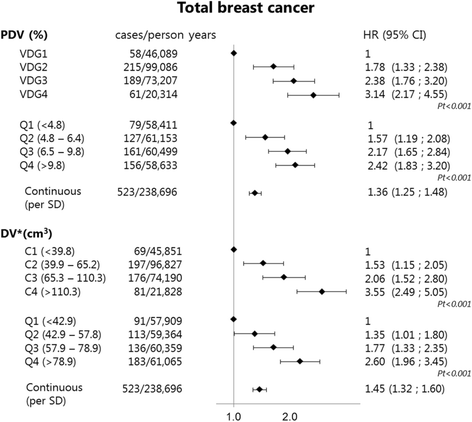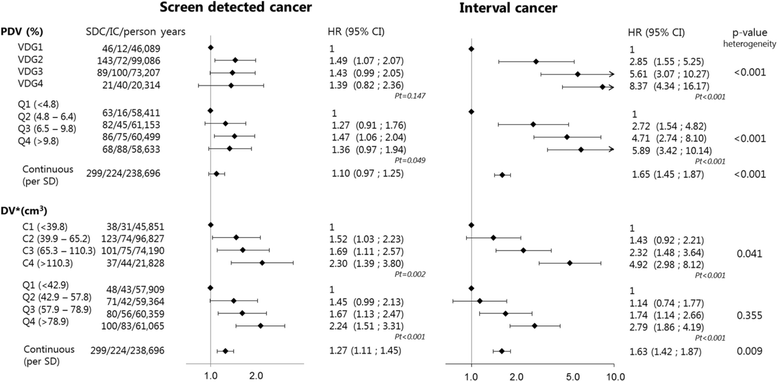The effect of volumetric breast density on the risk of screen-detected and interval breast cancers: a cohort study
- PMID: 28583146
- PMCID: PMC5460501
- DOI: 10.1186/s13058-017-0859-9
The effect of volumetric breast density on the risk of screen-detected and interval breast cancers: a cohort study
Abstract
Background: In the light of the breast density legislation in the USA, it is important to know a woman's breast cancer risk, but particularly her risk of a tumor that is not detected through mammographic screening (interval cancer). Therefore, we examined the associations of automatically measured volumetric breast density with screen-detected and interval cancer risk, separately.
Methods: Volumetric breast measures were assessed automatically using Volpara version 1.5.0 (Matakina, New Zealand) for the first available digital mammography (DM) examination of 52,814 women (age 50 - 75 years) participating in the Dutch biennial breast cancer screening program between 2003 and 2011. Breast cancer information was obtained from the screening registration system and through linkage with the Netherlands Cancer Registry. We excluded all screen-detected breast cancers diagnosed as a result of the first digital screening examination. During a median follow-up period of 4.2 (IQR 2.0-6.2) years, 523 women were diagnosed with breast cancer of which 299 were screen-detected and 224 were interval breast cancers. The associations between volumetric breast measures and breast cancer risk were determined using Cox proportional hazards analyses.
Results: Percentage dense volume was found to be positively associated with both interval and screen-detected breast cancers (hazard ratio (HR) 8.37 (95% CI 4.34-16.17) and HR 1.39 (95% CI 0.82-2.36), respectively, for Volpara density grade category (VDG) 4 compared to VDG1 (p for heterogeneity < 0.001)). Dense volume (DV) was also found to be positively associated with both interval and screen-detected breast cancers (HR 4.92 (95% CI 2.98-8.12) and HR 2.30 (95% CI 1.39-3.80), respectively, for VDG-like category (C)4 compared to C1 (p for heterogeneity = 0.041)). The association between percentage dense volume categories and interval breast cancer risk (HR 8.37) was not significantly stronger than the association between absolute dense volume categories and interval breast cancer risk (HR 4.92).
Conclusions: Our results suggest that both absolute dense volume and percentage dense volume are strong markers of breast cancer risk, but that they are even stronger markers for predicting the occurrence of tumors that are not detected during mammography breast cancer screening.
Keywords: Interval breast cancer risk; Mammography screening; Volumetric mammographic breast density.
Figures


Similar articles
-
The combined effect of mammographic texture and density on breast cancer risk: a cohort study.Breast Cancer Res. 2018 May 2;20(1):36. doi: 10.1186/s13058-018-0961-7. Breast Cancer Res. 2018. PMID: 29720220 Free PMC article.
-
Volumetric breast density affects performance of digital screening mammography.Breast Cancer Res Treat. 2017 Feb;162(1):95-103. doi: 10.1007/s10549-016-4090-7. Epub 2016 Dec 23. Breast Cancer Res Treat. 2017. PMID: 28012087 Free PMC article.
-
Automated measurement of volumetric mammographic density: a tool for widespread breast cancer risk assessment.Cancer Epidemiol Biomarkers Prev. 2014 Sep;23(9):1764-72. doi: 10.1158/1055-9965.EPI-13-1219. Epub 2014 Jul 10. Cancer Epidemiol Biomarkers Prev. 2014. PMID: 25012995
-
Using tumor phenotype, histological tumor distribution, and mammographic appearance to explain the survival differences between screen-detected and clinically detected breast cancers.APMIS. 2014 Aug;122(8):699-707. doi: 10.1111/apm.12294. APMIS. 2014. PMID: 25046200 Review.
-
A Review of Breast Density Implications and Breast Cancer Screening.Clin Breast Cancer. 2020 Aug;20(4):283-290. doi: 10.1016/j.clbc.2020.03.004. Epub 2020 Mar 20. Clin Breast Cancer. 2020. PMID: 32334975 Review.
Cited by
-
Does Breast Density Increase the Risk of Re-excision for Women with Breast Cancer Having Breast-Conservation Therapy?Ann Surg Oncol. 2019 Dec;26(13):4246-4253. doi: 10.1245/s10434-019-07647-7. Epub 2019 Aug 8. Ann Surg Oncol. 2019. PMID: 31396783 Free PMC article.
-
Contrast-enhanced MRI for breast cancer screening.J Magn Reson Imaging. 2019 Aug;50(2):377-390. doi: 10.1002/jmri.26654. Epub 2019 Jan 18. J Magn Reson Imaging. 2019. PMID: 30659696 Free PMC article. Review.
-
A practical work around for breast density distribution discrepancies between mammographic images from different vendors.Eur Radiol. 2025 Aug;35(8):4885-4892. doi: 10.1007/s00330-025-11383-w. Epub 2025 Jan 31. Eur Radiol. 2025. PMID: 39890617 Free PMC article.
-
Diagnostic accuracy of automated ACR BI-RADS breast density classification using deep convolutional neural networks.Eur Radiol. 2023 Jul;33(7):4589-4596. doi: 10.1007/s00330-023-09474-7. Epub 2023 Mar 1. Eur Radiol. 2023. PMID: 36856841 Free PMC article.
-
A new automated method to evaluate 2D mammographic breast density according to BI-RADS® Atlas Fifth Edition recommendations.Eur Radiol. 2019 Jul;29(7):3830-3838. doi: 10.1007/s00330-019-06016-y. Epub 2019 Feb 15. Eur Radiol. 2019. PMID: 30770972
References
Publication types
MeSH terms
LinkOut - more resources
Full Text Sources
Other Literature Sources
Medical
Molecular Biology Databases
Miscellaneous

